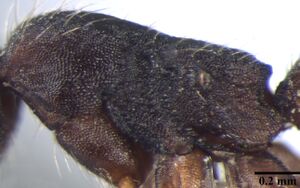Aenictus wilsoni
| Aenictus wilsoni | |
|---|---|

| |
| Scientific classification | |
| Kingdom: | Animalia |
| Phylum: | Arthropoda |
| Class: | Insecta |
| Order: | Hymenoptera |
| Family: | Formicidae |
| Subfamily: | Dorylinae |
| Genus: | Aenictus |
| Species: | A. wilsoni |
| Binomial name | |
| Aenictus wilsoni Bharti, Wachkoo & Kumar, 2012 | |
Known only from the type material. Andretta, the type locality of this species is a fascinating green hill station (devoid of litter) surrounded on all sides by tea gardens and pine forests before they merge with the Dhauladhar range (a southern branch of the main Outer Himalayan chain of mountains). This species is uncommon in the Shivalik range of northwest Himalaya and was collected twice from the same locality while the ants were raiding on the soil surface.
Identification
Bharti et al. (2012) - Aenictus wilsoni can be easily separated from Aenictus pangantihoni and Aenictus rabori by its microrecticulate head capsule but is somewhat similar to Aenictus philippinensis from which it can be fairly separated by a combination of characters. Aenictus philippinensis has medium reddish brown color, smaller scapes (SI, 78.20), convex basal face of the propodeum and a strongly impressed metanotum, whereas Aenictus wilsoni has a blackish color, longer scapes (SI, 93.15–100), straight basal face of propodeum and indistinct metanotal impression. Presence of rugae, ridge immediately followed by three fossae; an oblique excavation present between the lower 1/3 of the meso and metapleuron are found in latter only.
Keys including this Species
Distribution
Latitudinal Distribution Pattern
Latitudinal Range: 32.0744° to 32.0744°.
| North Temperate |
North Subtropical |
Tropical | South Subtropical |
South Temperate |
- Source: AntMaps
Distribution based on Regional Taxon Lists
Oriental Region: India (type locality).
Distribution based on AntMaps
Distribution based on AntWeb specimens
Check data from AntWeb
Countries Occupied
| Number of countries occupied by this species based on AntWiki Regional Taxon Lists. In general, fewer countries occupied indicates a narrower range, while more countries indicates a more widespread species. |

|
Estimated Abundance
| Relative abundance based on number of AntMaps records per species (this species within the purple bar). Fewer records (to the left) indicates a less abundant/encountered species while more records (to the right) indicates more abundant/encountered species. |

|
Biology
Castes
Known only from the worker caste.
Images from AntWeb

| |
| Holotype of Aenictus wilsoni. Worker. Specimen code antweb1008020. Photographer H. Bharti, uploaded by California Academy of Sciences. | Owned by PUN, Punjabi University, Patiala, India. |
Nomenclature
The following information is derived from Barry Bolton's Online Catalogue of the Ants of the World.
- wilsoni. Aenictus wilsoni Bharti, Wachkoo & Kumar, 2012: 292, figs. 5-8 (w.) INDIA (Himachal Pradesh).
- Type-material: holotype worker, 14 paratype workers.
- Type-locality: holotype India: Himachal Pradesh, Andretta,32.0744°N, 76.5856°E, 940 m., 12.vi.2010, hand picking (A.A. Wachkoo); paratypes with same data.
- Type-depositories: PUAC (holotype); BMNH, MCZC, PUAC (paratypes).
- Status as species: Bharti, Guénard, et al. 2016: 21.
- Distribution: India.
Unless otherwise noted the text for the remainder of this section is reported from the publication that includes the original description.
Description
Worker
TL, 4.02–4.32; HL, 0.79–0.84; HW, 0.7–0.74; SL, 0.68–0.71; WL, 1.30–1.38; PL1, 0.31–0.33; PL2, 0.34–0.41; GL, 1.25–1.37. Indices: CI, 85.06–90.12; SI, 93.15–100 (n=15).
Head. Head longer than broad; narrowed posteriorly, sides convex; seen in full face view its posterior margin convex; some specimens have occiput with well demarcated collar. Parafrontal ridge distinct, about 0.27 mm long. Antenna 10 segmented; scape reaching up to the posterior margin of head. Clypeus convex, extending slightly anterior of frontal lobes; mandible broad, triangular with large apical tooth, followed by eight irregular, ill defined denticles.
Mesosoma. Promesonotum gently convex in profile; propodeum lower than promesonotum, its dorsal outline straight. Mesonotum demarcated from the mesopleuron by a distinct ridge; which is immediately followed by three fossae placed horizontally; metanotal impression indistinct. An oblique excavation is present between the lower 1/3 of the meso and metapleuron. Propodeal junction forms an angle of about 90°.
Petiole, Postpetiole. Petiole rectangular in dorsal view, margined anteriorly by a transverse carina. Postpetiole gibbous, broadened posteriorly; subpetiolar process a low, almost non-existent inconspicuous convex lobe.
Gaster. Gaster oval, sting exerted.
Sculpture. Head, mesosoma, petiole and postpetiole entirely microreticulate and opaque. In addition, low ill defined longitudinal rugae cover mesonotum and propodeum; lower half of mesopleuron consists of broad, sturdy rugae as well. Mandibles striate with punctured apices.
Pilosity. Moderate; suberect, denser on antennae and legs; sparse on gaster.
Color. Blackish, with brown gena, gaster, and appendages.
Type Material
Holotype worker. India, Himachal Pradesh, Andretta, 32.0744°N 76.5856°E, 940 m, 12.vi.2010, hand picking (coll. Aijaz A. Wachkoo). 14 paratype workers; same data as holotype.
Etymology
The species epithet is given to honor E. O. Wilson.

